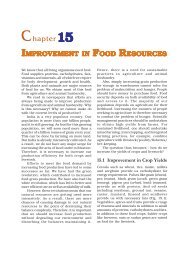C
Create successful ePaper yourself
Turn your PDF publications into a flip-book with our unique Google optimized e-Paper software.
permeable surface, there is a simple flat kind<br />
of epithelium. This is called the simple<br />
(a) Squamous<br />
(b) Cuboidal<br />
(c) Columnar (Ciliated)<br />
squamous epithelium. Simple squamous<br />
epithelial cells are extremely thin and flat and<br />
form a delicate lining. The oesophagus and<br />
the lining of the mouth are also covered with<br />
squamous epithelium. The skin, which<br />
protects the body, is also made of squamous<br />
epithelium. Skin epithelial cells are arranged<br />
in many layers to prevent wear and tear. Since<br />
they are arranged in a pattern of layers, the<br />
epithelium is called stratified squamous<br />
epithelium.<br />
Where absorption and secretion occur, as<br />
in the inner lining of the intestine, tall<br />
epithelial cells are present. This columnar<br />
(meaning ‘pillar-like’) epithelium facilitates<br />
movement across the epithelial barrier. In the<br />
respiratory tract, the columnar epithelial<br />
tissue also has cilia, which are hair-like<br />
projections on the outer surfaces of epithelial<br />
cells. These cilia can move, and their<br />
movement pushes the mucus forward to clear<br />
it. This type of epithelium is thus ciliated<br />
columnar epithelium.<br />
Cuboidal epithelium (with cube-shaped<br />
cells) forms the lining of kidney tubules and<br />
ducts of salivary glands, where it provides<br />
mechanical support. Epithelial cells often<br />
acquire additional specialisation as gland<br />
cells, which can secrete substances at the<br />
epithelial surface. Sometimes a portion of the<br />
epithelial tissue folds inward, and a<br />
multicellular gland is formed. This is<br />
glandular epithelium.<br />
6.3.2 CONNECTIVE TISSUE<br />
(d) Stratified squamous<br />
Fig. 6.9: Different types of epithelial tissues<br />
Blood is a type of connective tissue. Why<br />
would it be called ‘connective’ tissue? A clue<br />
is provided in the introduction of this chapter!<br />
Now, let us look at this type of tissue in some<br />
more detail. The cells of connective tissue are<br />
loosely spaced and embedded in an<br />
intercellular matrix (Fig. 6.10). The matrix<br />
may be jelly like, fluid, dense or rigid. The<br />
nature of matrix differs in concordance with<br />
the function of the particular connective<br />
tissue.<br />
Take a drop of blood on a slide and observe<br />
different cells present in it under a microscope.<br />
TISSUES 75
















